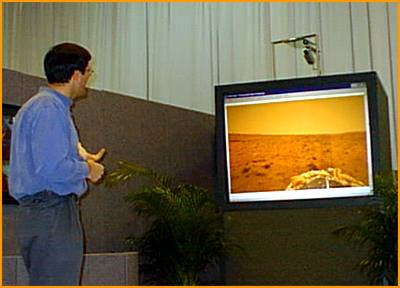 Join now for free!
Join now for free!
MENU
Reviews
Just In
All comparisons
Features
How To
Digital Life
Techno
CNET TV
The shows
The hosts
Airtimes
CNET Studios
Community
About CNET
Feedback
Member Services
Posting
Current poll
Conferences
CNET jobs
Permissions
Resources
Software Central
Glossary
Help
CNET SERVICES
NEWS.COM
COMPUTERS.COM
BUILDER.COM
GAMECENTER.COM
DOWNLOAD.COM
SHAREWARE.COM
BROWSERS.COM
ACTIVEX.COM
SEARCH.COM
MEDIADOME.COM
SNAP! ONLINE
MARKETPLACE
BUYDIRECT.COM
Specials
How to advertise
|
|
 |

walk on Mars! The Visualization Space computer scans a room to establish a baseline background, then creates outlines of human forms as they move through the space. Using in-depth color analysis, the computer can keep track of hands and limbs. Users can then point at, grab, and move virtual objects without resorting to clunky VR gloves or other pointing devices. Vague phrases like "make it bigger" result in onscreen action, and the application can learn exactly what each user means by every phrase. You can even navigate virtual spaces simply by walking around. Moving to the left or right gives you a different viewing angle, and to move from place to place, you need only point at a spot on the screen and say, "Go there." The demonstration we saw featured a VRML world created with the recent Pathfinder data, allowing the user to "walk" on Mars.
It's cool, but don't expect to see Visualization Space on your desktop
anytime in the next couple of years: even on a quad
Pentium Pro system with half a gigabyte of RAM, the demo ran slowly.
Friday, Nov 21, 1997
|
Back to top
Copyright © 1995-98 CNET, Inc. All rights reserved.